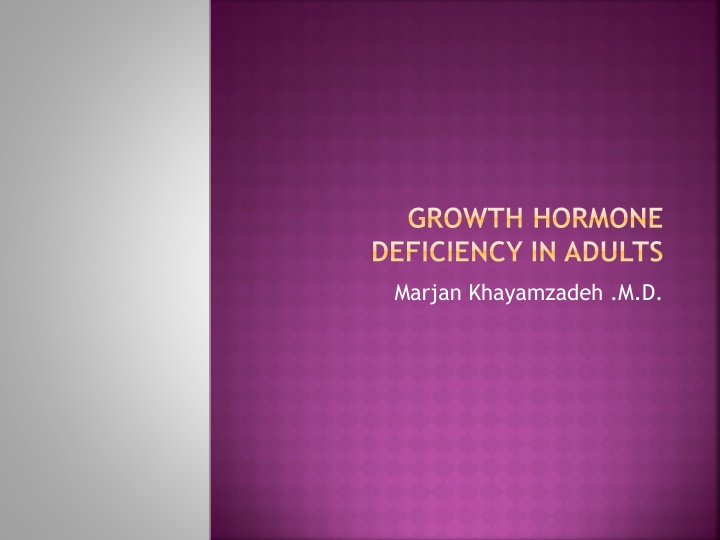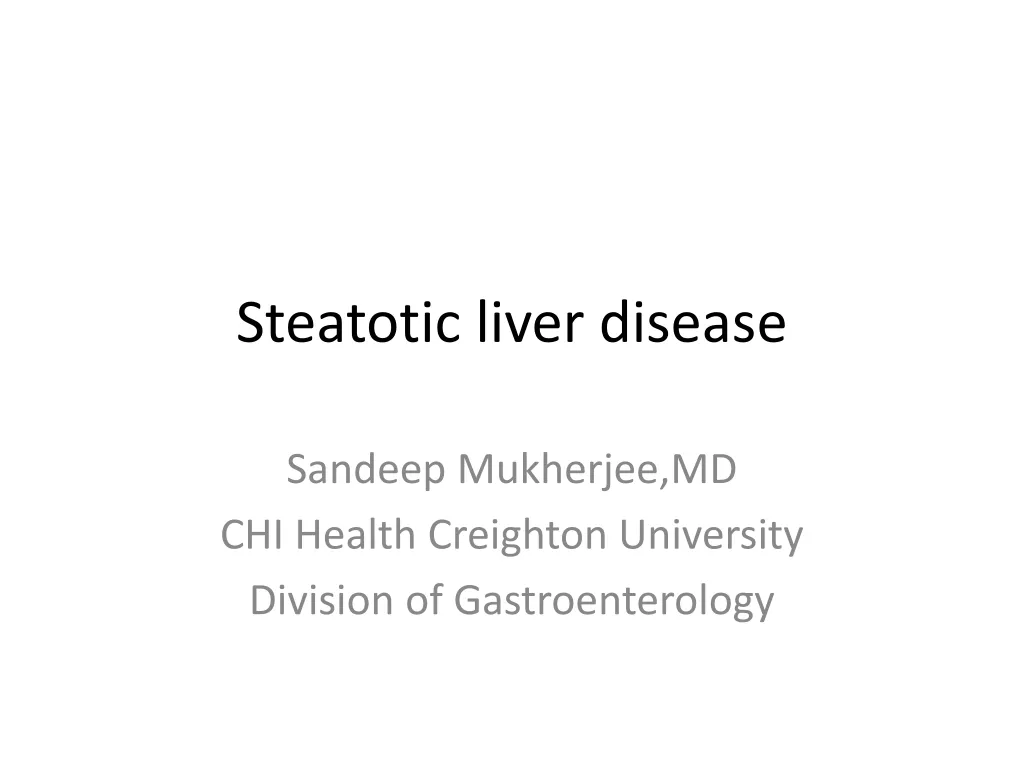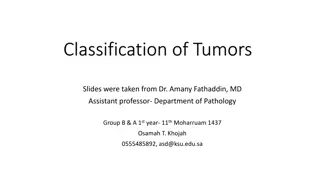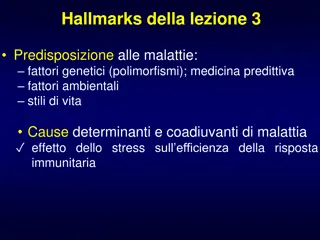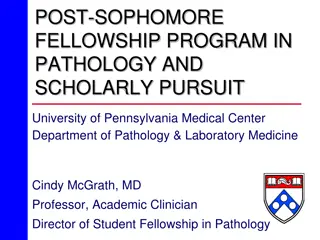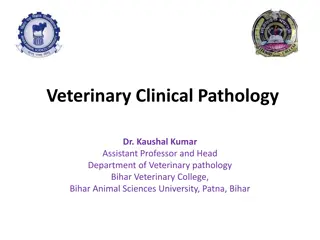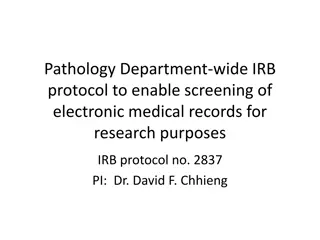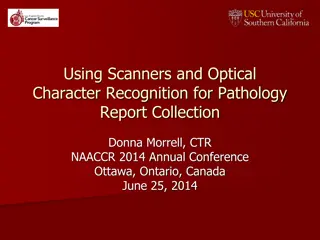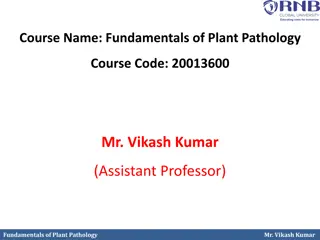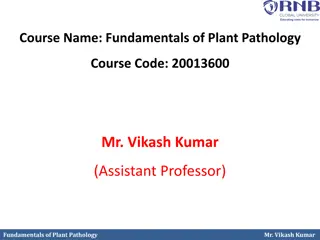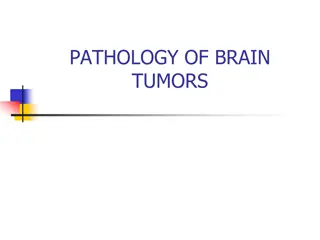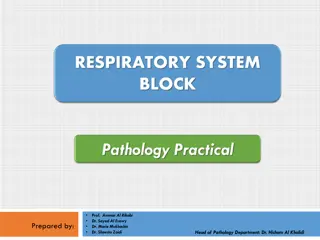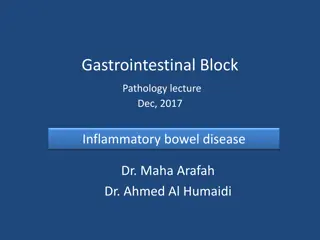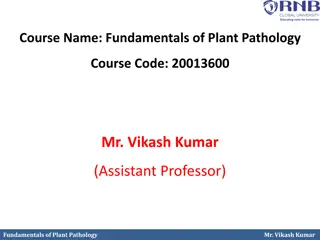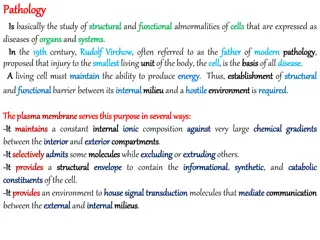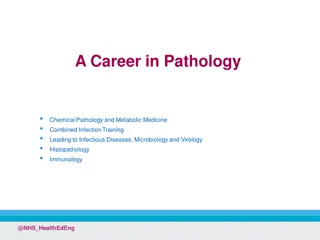Introduction to Pathology: Understanding Disease Processes
Pathology is the study of diseases, exploring abnormalities in the structure and function of the body. It involves understanding etiology, pathogenesis, molecular changes, and clinical manifestations to diagnose conditions accurately. This diagram illustrates how these terms apply to the development of Aphthous ulcers.
Download Presentation

Please find below an Image/Link to download the presentation.
The content on the website is provided AS IS for your information and personal use only. It may not be sold, licensed, or shared on other websites without obtaining consent from the author.If you encounter any issues during the download, it is possible that the publisher has removed the file from their server.
You are allowed to download the files provided on this website for personal or commercial use, subject to the condition that they are used lawfully. All files are the property of their respective owners.
The content on the website is provided AS IS for your information and personal use only. It may not be sold, licensed, or shared on other websites without obtaining consent from the author.
E N D
Presentation Transcript
GROWTH HORMONE DEFICIENCY IN ADULTS Marjan Khayamzadeh .M.D.
AGENDA Etiology Clinical manifestation Diagnosis(stimulation test cut points) Transion period GHtherapy(doses,monitoring,benefits, adverse events)
DIAGNOSIS lack of a single biological end-point, such as growth failure secreted episodically in a pulsatile pattern and modified by age, gender, and body mass index (BMI) Disease State Clinical Review, Endocr Pract. 2016;22
insulin-like growth factor 1 (IGF-1) and IGF- binding protein 3 (IGFBP-3) have also shown poor diagnostic value due to overlap between healthy and GH-deficien individuals, particularly in adults over 40 years. random GH and IGF-1 levels cannot be used alone, GH stimulation tests are required to confirm the diagnosis. Disease State Clinical Review, Endocr Pract. 2016;22
The GH Research Society has mandated that utilizing one reliable GH stimulation test is sufficient , with the exception for the need of a GH stimulation test in patients who meet criteria that predict GHD with high specificity: A)patients with organic pituitary disease and three or more pituitary hormone deficits and low serum IGF-1 levels. B)patients with congenital/genetic GHD Disease State Clinical Review, Endocr Pract. 2016;22
TRNSITION PERIOD The transition from pediatric to adult care is an appropriate time for reassessment of GH status. Patients with a high likelihood of having permanent GHD are those who have MPHD and a serum IGF-I concentration below the normal range (off GH therapy) if associated with one or more of the following: J Clin Endocrinol Metab, June 2011, 96(6):1587 1609
1) a radiologically confirmed congenital anomaly in the sellar or suprasellar region; 2)known acquired hypothalamic-pituitary disease, e.g. craniopharyngioma; 3) previous surgery for lesions directly affecting the hypothalamic-pituitary region J Clin Endocrinol Metab, June 2011, 96(6):1587 1609
or radiotherapy for malignant disease that included a high dose of irradiation to the hypothalamic-pituitary region 4) a proven genetic/molecular defect involving the capacity to secrete GH. If children in these categories have a low IGF-I level on no GH treatment, this generally suffices to document continuing GHD. J Clin Endocrinol Metab, June 2011, 96(6):1587 1609
Those children with idiopathic GHD, either isolated or with one additional hormone deficit, are less likely to have permanent GHD and should be retested in early adulthood using the stimulation tests. Testing should be conducted after discontinuation of GH treatment for at least 1 month to avoid possible suppression of endogenous responses. J Clin Endocrinol Metab, June 2011, 96(6):1587 1609
ITT gold-standard test for evaluation of adult GHD its safety concerns hamper wider use in the United States IV insulin 0.05-0.15 U/kg. Record neuroglycopenic symptoms. Blood sampling: fasting,and 20, 30, 40, and 60 min after a hypoglycemia is achieved.
Interpretation of GHD: GH <3-5 mg/L at every time point after a hypoglycemia is achieved. Contra-indications: epilepsy, cardiovascular disease, pregnancy, age >65 years. PPV 93%, sensitivity 96% and specificity 92%.
GHRH-ARGININE Bolus dose of IV GHRH 1 mg/kg (maximum 100 mg) at baseline, followed by IV arginine infusion 0.5 g/kg (maximum 30 g) over 30 min. Blood sampling 0,30, 60, 90, and 120 m BMI-dependent cutpoints: - BMI <25 kg/m2, 11mg/L at every time point - BMI 25-30 kg/m2, 8mg/L at every time point - BMI 25 kg/m2, 4mg/L at every time pointin.
May yield false negative results in hypothalamic GHD. PPV 92%, sensitivity 95%,and specificity 91%.
ARGININE 30 g arginine HCl (10% solution) infused over 30 min. Measure GH at 30-min intervals for 2.5 h Cutpoints:GH 0.4 mg/L at every time point. Weak GH secreatagogue.Requires very low GH cut-points to achieve optimal specificity. PPV 92%, sensitivity 87%,and specificity 91%.
GLUCAGON 1 mg (1.5 mg if >90 kg) IM. Measure GH every 30 min for 4h. GH 3 mg/L at every time point. Questionable diagnostic accuracy in subjects with high BMIs and glucose intolerance. Requires lower BMI-dependent GH cut-points to achieve optimal specificity. Sensitivity and specificity 100% in lean subjects.
CONCLUSION The GST correctly classified GHD using GH cut-points of 1 ng/ml for FD-GST and 2 ng/ml for WBGST,hence using 3 ng/ml as the GH cut-point will misclassify some GH- sufficient adults. The GST may also be an acceptable alternative to the ITT for evaluating the HPA axis utilizing cortisol cut-points of 9 lg/dL for FD-GST and 11 lg/dL for WB-GST.
GH THERAPY In UK clinical practice, patients are selected for treatment on the basis of perceived need according to one or more of a number of specific criteria outlined below. defined severe GHD with the insulin tolerance test (ITT), glucagon, arginine, or alternative tests such as arginine plus growth hormone releasing hormone (GHRH). Adult Growth Hormone Deficiency,2015
Peak GH response <9mU/l (<3ng/mL) to ITT. The appropriate threshold for the diagnosis of severe GHD using the other provocative tests needs to be cross-validated against the "gold standard" - the ITT definition. Patient already receiving full supplementation of other deficient hormones as required.
Reduced QoL is the major indication for offering GH replacement. The selection of whom to treat is based on the patient's own perception of QOL reinforced by the objective assessment utilising a disease- specific questionnaire ("adult growth hormone deficiency assessment" - AGHDA) or alternative validated questionnaire
GH replacement should also be considered in patients in whom an adverse cardiovascular risk profile and/or osteopenia have been demonstrated.
The aim of GH replacement therapy is to treat the signs and symptoms of GHD by correcting the metabolic abnormalities and impaired QoL associated with AGHD. women require more GH per kilogram of body weight than men, younger patients require more GH than older patients, and adult patients who had childhood-onset require more GH than adult-onset GHD to obtain an equivalent clinical response. Neurol Med Chir (Tokyo) 54, August, 2014
GH replacement therapy should start with a low dose, especially in older individuals (0.1 mg/day), administered as daily subcutaneous injections in the evening. GH dosages should be increased gradually and individualized, on the basis of clinical and biochemical responses, no more frequently than at monthly intervals. Neurol Med Chir (Tokyo) 54, August, 2014
Incremental dose increases should be between 0.1 mg/day and 0.2 mg/day. Clinical status and serum IGF-I levels should be monitored. The GH maintenance dose should seldom exceed 1.0 mg/day. Neurol Med Chir (Tokyo) 54, August, 2014
CONCLUSION In GH-deficient adults, there was no evidence for a GH treatment effect on death,cancer, intracranial tumor recurrence, diabetes, or cardiovascular events. The identification of unexpected GH-related AEs reinforces the fact that patient selection and GH dose titration are important to ensure safety of adult GH replacement.
